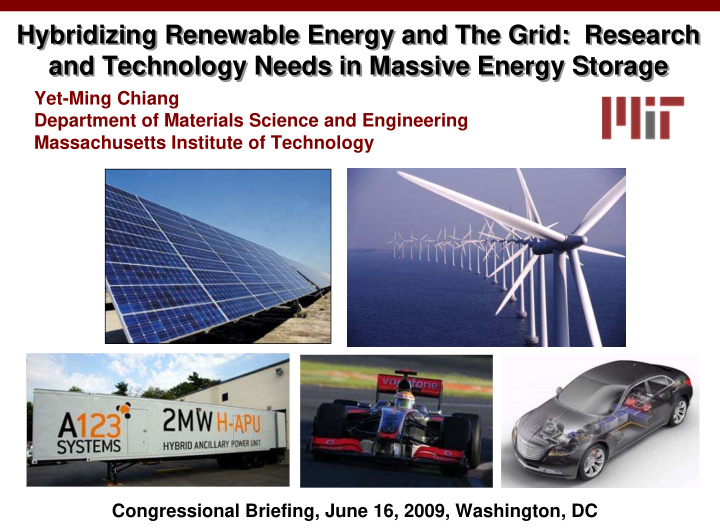



Hybridizing Renewable Energy and The Grid: Research Hybridizing Renewable Energy and The Grid: Research and Technology Needs in Massive Energy Storage and Technology Needs in Massive Energy Storage Yet-Ming Chiang Department of Materials Science and Engineering Massachusetts Institute of Technology Congressional Briefing, June 16, 2009, Washington, DC
Two huge industries are transforming…. Storage is the problem and the solution... Battery Industry
Consider That Vehicles Have Multiple Levels of Electrification ICE HEV Toyota Prius Honda Insight Ford Escape PHEV A123/Hymotion conversion GM Volt Chrysler 200C BEV Tesla Roadster Chrysler Circuit Fisker Karma TH!NK City engine battery 3
Ratio of Power(kW) to Stored Energy(kWh) Varies from ~100 (HEV) to ~1 (BEV)* HEV PHEV EV Charge- Charge- depleting sustaining *Comparison: The Design P/E is ~0.25 for Wind, Solar
Similarly, the Grid will be Hybridized Where storage can help US: 3% renewables Wind and Solar are Intermittent Sources (not “dispatchable”)
Frequency Regulation Example (GE) Frequency Regulation: Frequent charge and discharge pulses, but net energy transferred is zero. Analogous to a hybrid electric vehicle (HEV)… Load following is longer ‐ term analog to regulation: vary generation to meet hour ‐ to ‐ hour variations in load
Impact of Storage Time Constant: Wind+Battery Example (NEDO)
Comparing Time Constant and Total Power for Automotive and Grid EV V E H P HEV 8
Recent example: Impact of DOE Basic Science
Recent Advances in Li-Ion Batteries for Transportation Improve 1 st Gen Chemistry New Chemistry Engineering solution New chemistries that are “Extreme” pack Derivatives of oxide intrinsically safer, high engineering using chemistry from power, long-life, low-cost commodity laptop cells, previous generation individually cooled and Li-ion (aim to improve Example: Nanoscale Olivines monitored safety, life) Example: Tesla Roadster Examples: • Lithium Nickel Cobalt Aluminum (SAFT, PEVE) • Lithium Manganese Spinel (LG, NEC, Hitachi) • Lithium Manganese Nickel Cobalt (Sanyo) • Mixtures of various oxides
Electric
Formula 1 Racing: Pushing the Outer Performance Envelope of Hybrid Electric Drive • 2009: McLaren-Mercedes teams with A123 Systems to develop KERS (Kinetic Energy Recovery Systems) • Opening race of 2009 season in Melbourne, AUS • Lewis Hamilton, 2008 World Champion, starts in 18 th position (out of 20) and finishes 4th
Kinetic Energy Recovery System (KERS) in Action Mercedes High Performance Engines Battery State-of-Charge Melbourne March 2009
Frequency Regulation with the World’s largest Li-Ion Battery • 2 MW power, 90% round-trip efficiency • 0.5 MWh stored energy • 82,000 cylindrical cells • 1.2 tonnes cathode material • 2.3 x 10 17 nanoparticles (40 nm dia.)
Why science breakthroughs still needed for automotive…… Range (miles) x 300 Wh/mile = 15 kWh for 40 mile PHEV 0.8 (20% reserve capacity) Energy = 75 kWh for 200 mile BEV ÷ = 136 kg for 40 mile PHEV 110 Wh/kg Mass Typical of = 681 kg for 200 mile BEV (too heavy!) current Li-ion ÷ = 220 Wh/L 68 L for 40 mile PHEV Volume = (too big!) 341 L for 200 mile BEV Target x = US$7500 for 40 mile PHEV US$0.50/Wh cost Cost = (too US$37,500 for 200 mile BEV ~Similar cost to Na-S expensive!) Not to mention that charging a 75 kWh pack in 1h takes 75 kW; in 5 min takes 900 kW…..
Massive Energy Storage Is Even More Demanding in Terms of Scalability, Cost, Safety, Life Main MES Options: • Pumped Hydro • Compressed Air • Sodum-sulfur • Redox flow • Lithium-ion V E Why Electrochemical Storage: PHEV A123 • Higher energy density Multi- than all but nuclear MW Li- • Use it anywhere Ion Battery E • Can be safe, long-life H System V • Can use low-cost, earth- abundant materials Challenge: No current system combines all of these attributes in the same battery
Interdependence in the Energy Ecosystem Grid-scale energy storage PHEV, E-REV, EV
Recommend
More recommend